Spring is officially here. But before you start scheduling outdoor picnics to celebrate that extra hour of sunlight, you may want to add one more item to your spring cleaning list.
The task in question?
Washing, organizing, and storing your winter coats. Because you don’t want a pile of sweat-stained, smoky, rain-splattered jackets and puffer vests in cluttering your closet when you need to make room for shorts and open-toed shoes.
But before you set aside your winter outerwear for the next few seasons (with a Clutter pickup, perhaps?), read on to learn how to properly clean and store your winter coats to keep them in tip-top shape.
Various Winter Coats and How to Care for Them
Wool Coats
Care Tips:
Brushing and Spot Cleaning: Wool coats are a staple for winter due to their warmth and classic look. Gently brush away dirt and debris using a soft-bristled brush, to maintain their appearance. For small stains, use a damp cloth and gently dab the area with a mild detergent.
Dry Cleaning: Wool is delicate and can easily shrink. If not handled correctly. It’s best to have wool coats dry-cleaned at least once a season to keep them fresh and in good shape.
Example: Sarah has a favorite wool coat she wears every winter. She brushes it weekly to remove dust and lint and takes it to the dry cleaners at the end of each season to ensure it’s thoroughly cleaned and ready for storage.
Down Coats
Care Tips:
Machine Washing: Down coats are excellent for extreme cold due to their insulation. Wash them in a front-loading washing machine on a gentle cycle with cold water and mild detergent. Slinging some tennis balls in the dryer can be beneficial. Keep the down feathers from clumping.
Avoiding Heat: Down feathers can be damaged by high heat. Always dry your down coat on a low setting or air dry to maintain its insulating properties.
Example: Mark loves his down coat for its warmth. He washes it at home using a gentle detergent and always dries it with tennis balls to ensure the feathers stay evenly distributed.
Leather Coats
Care Tips:
Spot Cleaning: Leather coats are stylish and durable but require specific care. Using a wet cloth can be very useful to clean off dirt and can be very useful, and regularly apply a leather conditioner to maintain it material supple and prevent cracking.
Professional Cleaning: For a deep clean, take your leather coat to a professional cleaner who specializes in leather care to avoid any damage from water or harsh chemicals.
Example: Emma takes great care of her leather jacket by regularly conditioning it and ensuring it gets professional cleaning once a year to maintain its look and longevity.
Synthetic Coats
Care Tips:
Machine Washing: Synthetic coats, often made from materials like polyester, are generally easy to care for. Keep machine wash them on a gentle cycle with mild detergent.
Air Drying: To avoid any damage from heat, lay synthetic coats flat or hang them to air dry.
Example: John appreciates the convenience of his synthetic coat, which he washes at home and hangs to dry, keeping it in excellent condition throughout the winter.
Comprehensive Guide to Cleaning, Drying, and Storing Your Winter Coats
1. Must-Have Tools and Equipment for Cleaning
- Soft-bristled Brush: Ideal for removing surface dirt and lint from wool and synthetic coats.
- Mild Detergent: It is crucial for washing down synthetic coats, ensuring a thorough clean without damaging the fabric.
- Tennis Balls: These are useful for drying down coats and preventing the feathers from clumping.
- Leather Conditioner: Essential for maintaining the suppleness and appearance of leather coats.
- Drying Rack or Hangers: Air-drying coats must dry evenly without losing shape.
2. Essential Steps for Drying
- Air Drying: Lay your coats flat on a drying rack or hang them in a place with good air circulation. This method is essential for wool and synthetic coats to avoid heat damage.
- Tumble Drying: When drying down coats, use the lowest heat setting and add tennis balls to prevent the feathers from clumping and help them fluff up.
3. Preparing for Storage
- Cleaning: Before storing, ensure all coats are clean to prevent stains from setting or attracting pests. This means brushing, spot cleaning, or professional cleaning as needed.
- Repairing: Check for loose buttons, small tears, or other damage. Repair these issues before storage to prevent them from worsening.
- Thorough drying: It’s crucial to ensure your coats are completely dry before storage. This helps prevent mold and mildew, which can ruin the fabric and create bad smells.
4. Ensuring Complete Dryness Before Storage
- Air Dry: Allow coats to air dry completely, which can take several days for thicker materials.
- Use a Fan: Placing a fan nearby can speed up drying and ensure that coats dry evenly.
- Check for Dampness: Before storing, feel both the inside and outside of the coat to ensure no areas are damp.
5. Removing Lint and Hair
- Lint Roller: A lint roller effectively removes hair and lint from most types of coats.
- Fabric Brush: Use a fabric brush for more delicate materials like wool to avoid damaging the fabric while removing lint and hair.
6. Repairing Damage
- Sewing Kit: Keep a basic sewing kit on hand to fix small tears, reattach buttons, or mend loose threads.
- Professional Repairs: For significant damage, such as large tears or broken zippers, seek professional repair services for proper fixing.
7. Best Practices for Storing Coats and Jackets
- Choose the Right Storage Location: Keep your coats in a cool, dry spot, safely away from direct sunlight, to keep them looking fresh and new. If you actually want them to last, to prevent fading and damage.
- Use Proper Hangers: Invest in sturdy, padded hangers to maintain the coat’s shape and prevent shoulder marks.
- Garment Bags: Store coats in breathable garment bags to shield them from dust and moths while allowing air circulation.
- Storing in Boxes or Bins: Use acid-free tissue paper to prevent creasing and store coats in breathable containers to avoid moisture buildup.
- Avoiding Moth Damage: Place mothballs, cedar blocks, or lavender sachets in your storage space to deter moths.
How to Wash Your Winter Coats
1. Check the care tag for instructions
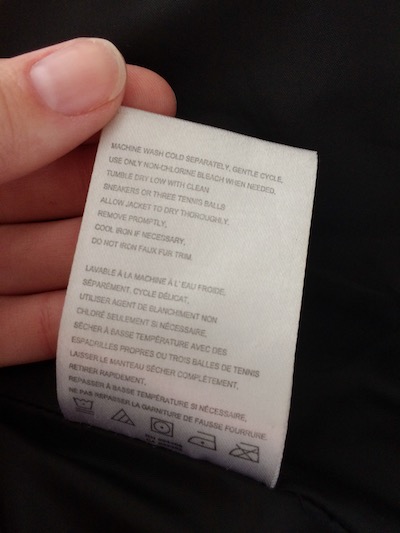
This is the first rule of thumb when washing anything. The care tag will usually have all the information you need, like whether or not your coat is machine-washable, which wash cycle and water temperature it needs, special instructions about specific detergents, and how to properly dry it.
Needless to say, you should interpret these instructions as rules, not suggestions. Your coat will thank you.
2. Pre-treat stains
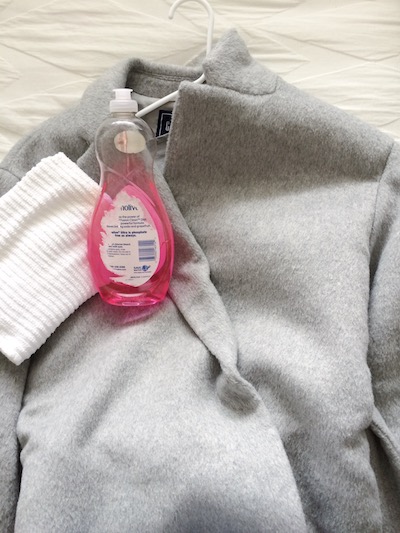
If you haven’t washed your winter coat all season, it probably has a few stains from food, dirty snow, puddle splashes, or just serious armpit sweating.
Pre-treat these stains with a stain remover or a squirt of Dawn dish soap. Apply the treatment to the stain, then let it soak for 10 minutes before tossing it in the washing machine or scrubbing it with a wet cloth.
3. Fasten all buttons and zippers
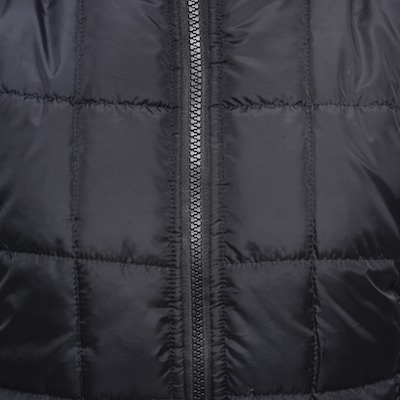
The metal teeth on the zippers can damage other clothes in the washing machine. To minimize the potential of snags and tears, it’s best to zip, fasten, and button everything on your coat before washing it.
This also helps your coat retain its shape as it tumbles around in the machine.
4. Wash similar materials together
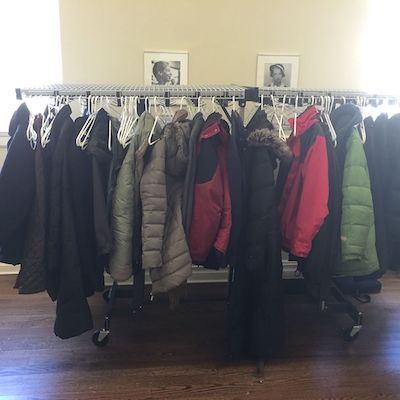
When certain opposite materials rub together, it can cause pilling, fading, or degradation to your clothes.
To keep your coats in prime condition, always wash them separately or with clothes of similar materials. Keep wool with wool, nylon with nylon, fleece with fleece, and so on.
Want more smart cleaning tips? Learn how to clean your bedding in five easy steps and how to wash and store your mattress properly.
Down Jackets, Parkas, and Puffer Coats
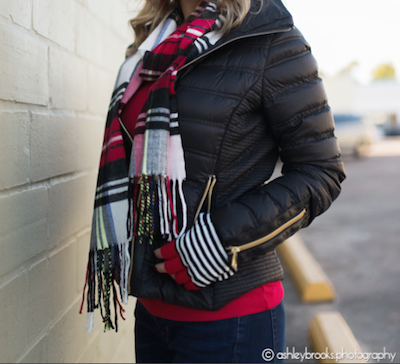
As a general rule, nylon and puffy, down-filled jackets, coats, and vests can all go in the washing machine. Wash them on a gentle cycle with cold water and regular detergent.
You can dry your puffer coats in the dryer, too. Besides being way more efficient than air-drying, the dryer is actually better for your these types of garments since it helps evenly re-distribute the down material. Just keep it on a low or gentle cycle.
To help fluff up your coats, add a couple of wool dryer balls to your load. Dryer balls are an easy, eco-friendly alternative to fabric softeners and dryer sheets — they soften and fluff your clothes, reduce wrinkling, and speed up the drying process.
If you’re in a pinch, clean tennis balls are also great fluffing tools.
Learn More: Check out these five insanely easy (and ridiculously effective) cleaning hacks
Wool Coats
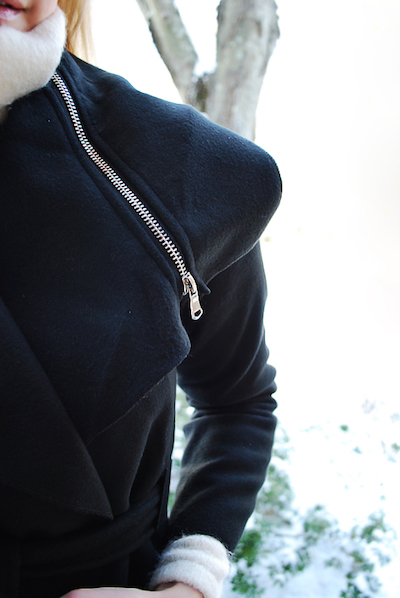
Regular detergents, hot water, and normal washing machine cycles can all cause the fibers in wool to break down or shrink. That’s why it’s crucial to be extra gentle with your fancy wool coat.
You can either hand-wash it in a tub with cold water and baby shampoo, or put it in the washing machine on a delicate cycle. If you do this, make sure you use cold water and a detergent specifically designed for dealing with wool products.
To dry it, lay your coat flat and use your hands to gently reshape the shoulders and arms as it dries.
Fleece Jackets
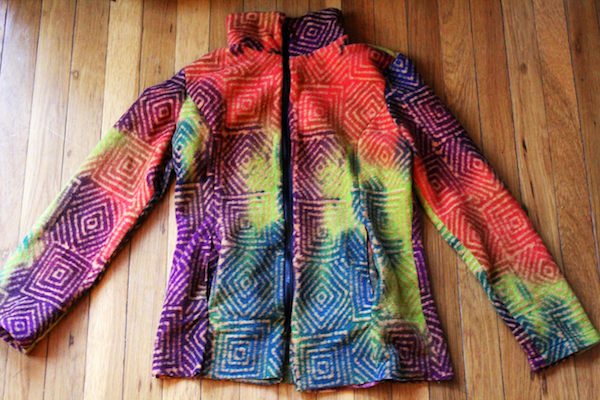
Fleece jackets are a year-round staple, but they do double-duty in the winter as comfy indoor loungewear and outdoorsy, sweat-proof outerwear. To freshen up your fleece jackets, turn them inside out, throw them in the washer, and set your machine’s settings to “cold” and “gentle.”
Your fleece will get linty and pilled — and may even become less water-resistant — if you wash it with materials like cotton, so be sure to keep it separate from your other clothes.
Hang it up to air-dry.
Leather Jackets, Suede, and Fur
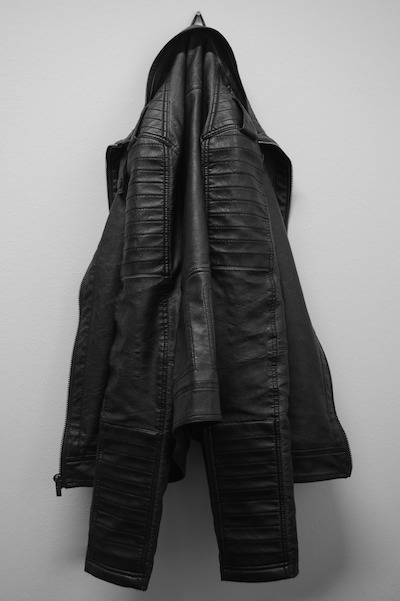
Don’t even attempt to wash your fur coats, leather jackets, or suede trenches at home. Take them to your local dry cleaners for a thorough, high-quality cleaning.
4 Easy Tips For Storing Your Winter Coats
1. Use wooden hangers
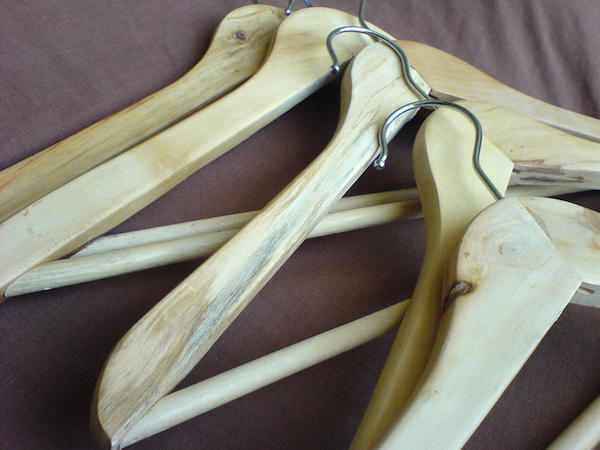
Coats made of natural materials like leather, suede, wool, and down need a little room to breathe. Hang them on sturdy wooden hangers so they can retain their shape and stay wrinkle-free.
If you want to go the extra mile, cover your coats in fabric garment bags to protect them from dust and mildew.
Pro Tip: Before you hang your coats, you may want to get organized. Here’s how to easily organize everything in your closet (for cheap).
2. Stack coats in plastic storage boxes
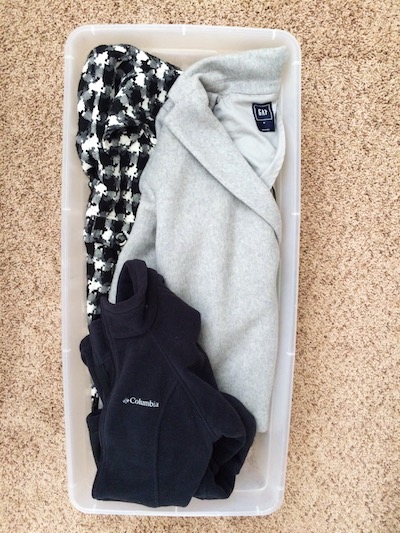
To save hanging space, store your fleece and nylon coats in plastic boxes. Gently fold and stack your coats so they don’t get misshapen.
If you have a pile of puffer vests and jackets made from polyfill (as opposed to down feathers), you can use vacuum-sealed plastic bags to squish them down to half their size and save double the closet space.
Learn More: While you’re at it, learn how to easily store your other winter accessories like hats, gloves, scarves, and boots
3. Store coats somewhere dry, cool, and dark
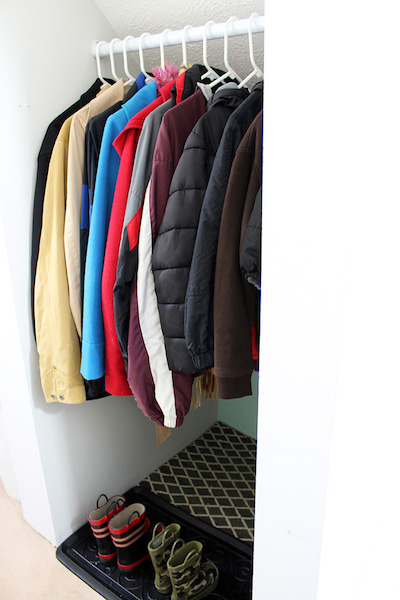
To avoid moisture build-up, mold, and damage from sunlight, store your coats someplace clean, cool, dry, and dark. Aim for a spot that hovers around 65 degrees Fahrenheit.
If your closet or entryway space is maxed out, slide your storage box below your bed or place it on the top shelf of your linen closet.
Want more clever tips for storing your winter necessities? We’ve got you covered: learn how to store your skis off-season, how to store your snowboards and snowboarding gear, and how to store your shoes, boots, and sneakers.
4. Store your coats with Clutter
If your apartment is short on space, use Clutter to safely store your winter jackets and coats.
Simply schedule a pickup and pack your stuff. We’ll grab everything from your home and transport it to our secure, temperature-controlled storage facility.
And when you need something back, just browse the convenient online photo catalog of your stuff, click the item’s photo, and we’ll deliver it back to you.
Special Tips for Long-Term Storage of Winter Coats
1. Climate Control: Store coats in a climate-controlled environment to protect them from extreme temperatures and humidity, which can cause damage.
2. Regular Checks: It’s important to periodically check on your stored coats to ensure they are not developing mold, mildew, or pest issues.
3. Proper Folding: Handle your coats with care by folding them loosely and avoiding pressing them too tightly. This meticulous approach will help you prevent deep creases and wrinkles, ensuring your coats look their best when you need them.
4. Vacuum-Sealed Bags: For certain types of coats, vacuum-sealed bags can save space but ensure they are breathable to prevent moisture buildup.
5. Labeling: Maintain an organized storage system by clearly labeling storage containers with the contents. This will give you a sense of control and make finding coats easy when needed.
Conclusion
Taking good care of your winter coats and storing them correctly keeps them in great shape for years to come. By following these detailed guidelines on cleaning, drying, repairing, and storing, you can extend the life of your coats and keep them looking their best. Whether it’s a ball of wool, down, leather, or synthetic jacket, each type requires specific care to maintain its functionality and appearance. Take the time to invest in the right tools and methods, and your winter coats will continue to provide warmth and style season after season.
Schedule a pickup with Clutter now!
Winter Coat Care FAQs
How often should you clean winter coats?
Winter coats should be cleaned at least once a season, preferably before storing them away for the warmer months. However, if your coat gets visibly dirty or stained, it’s best to clean it immediately.
Can you machine wash a wool coat?
It’s generally not recommended to machine wash a wool coat as it can cause shrinkage and damage. Instead, it’s best to dry clean or hand wash according to the care label instructions.
How do you remove tough stains from a down jacket?
To remove tough stains from a down jacket, spot clean with mild detergent and cold water. Gently rub the stained area with a soft cloth or sponge, then rinse thoroughly. A professional cleaner might be necessary for persistent stains.
Is it safe to store winter coats in vacuum-sealed bags?
While vacuum-sealed bags can save space, they can compress the fibers of some materials, leading to damage over time. It’s better to use breathable garment bags for long-term storage of winter coats.
What is the best way to store faux fur coats?
Store faux fur coats in a cool, dry place using a comprehensive, padded hanger to maintain their shape. Avoid compressing them, and consider using a breathable garment bag to protect them from dust and light.








